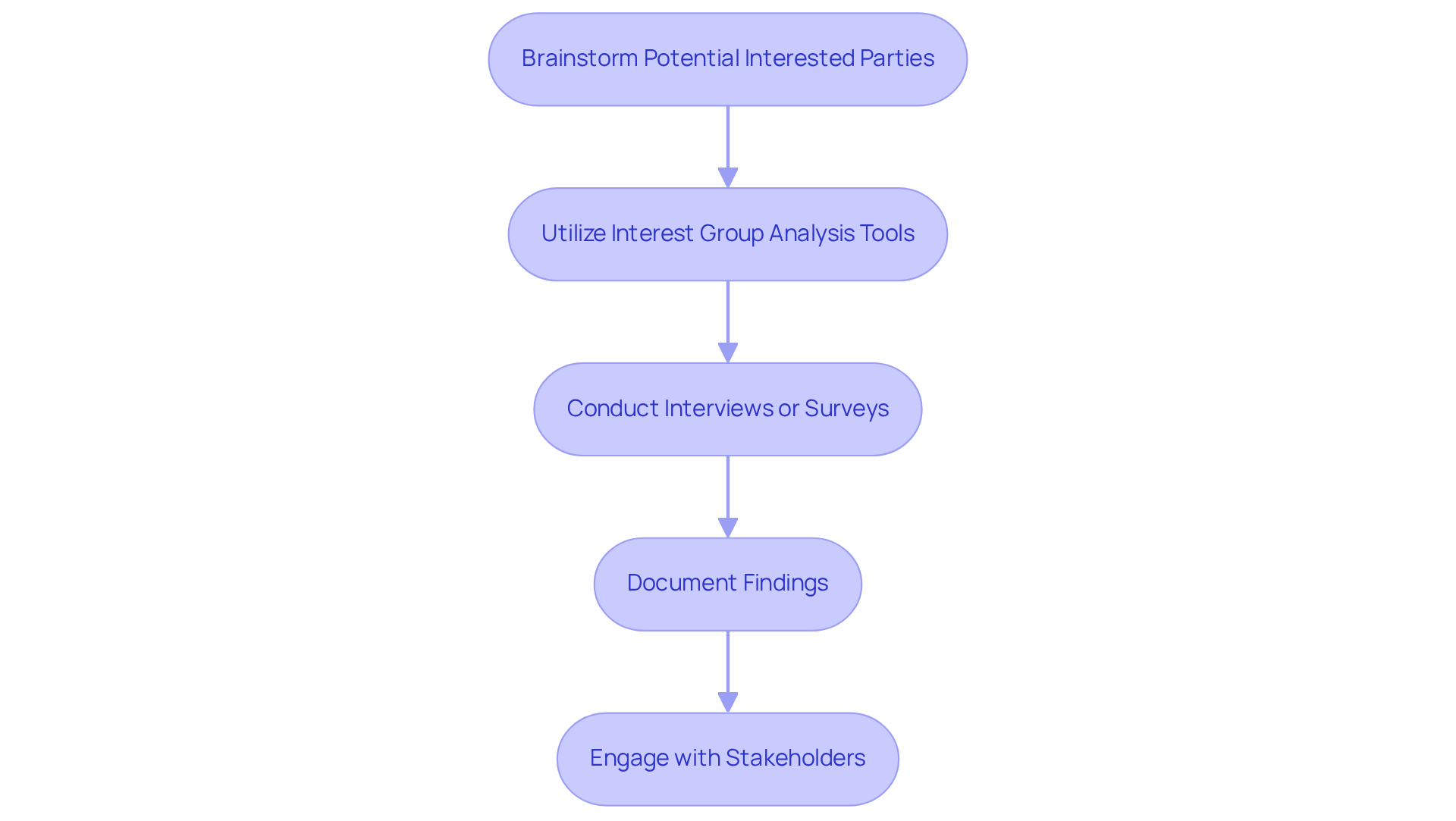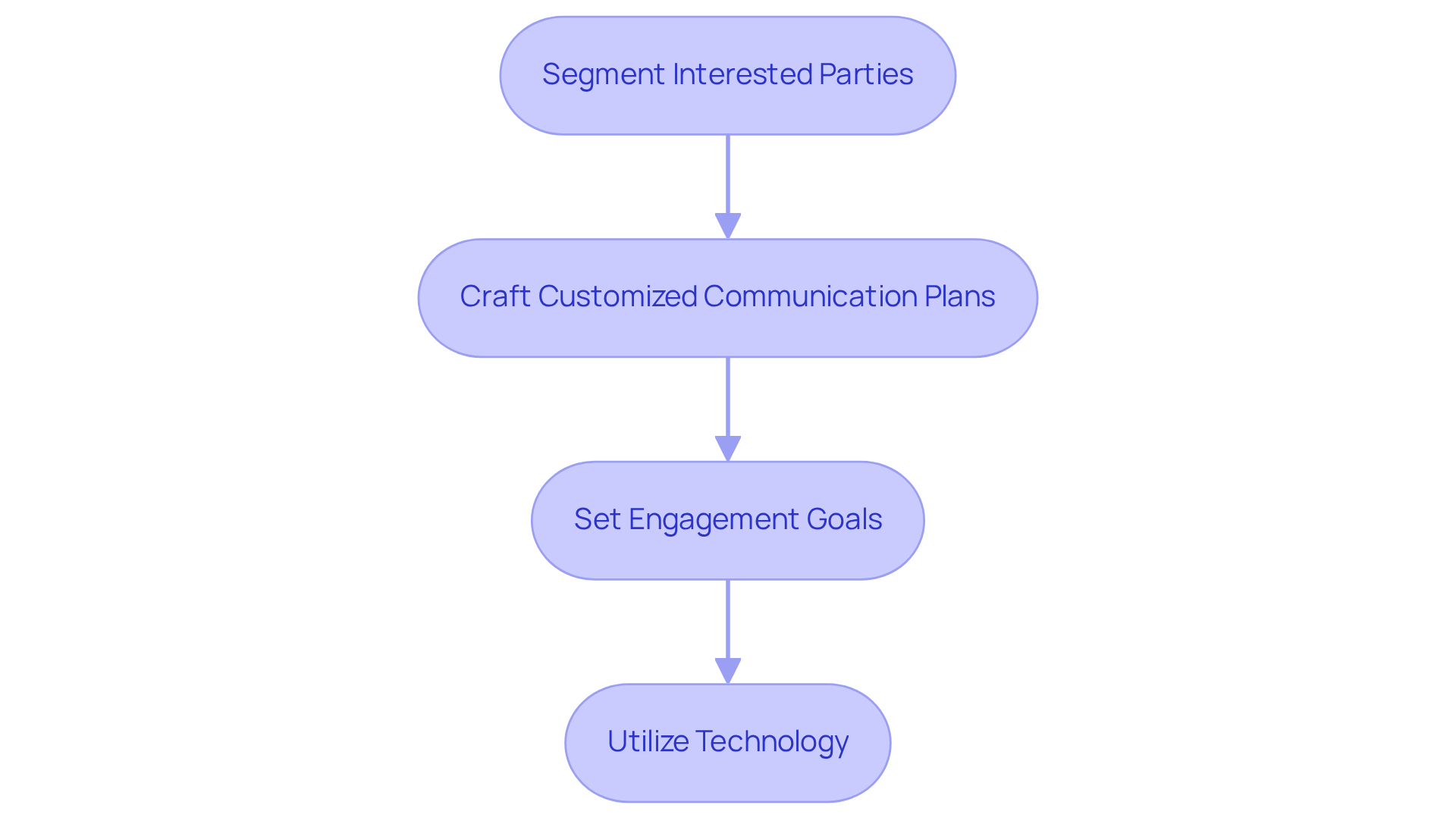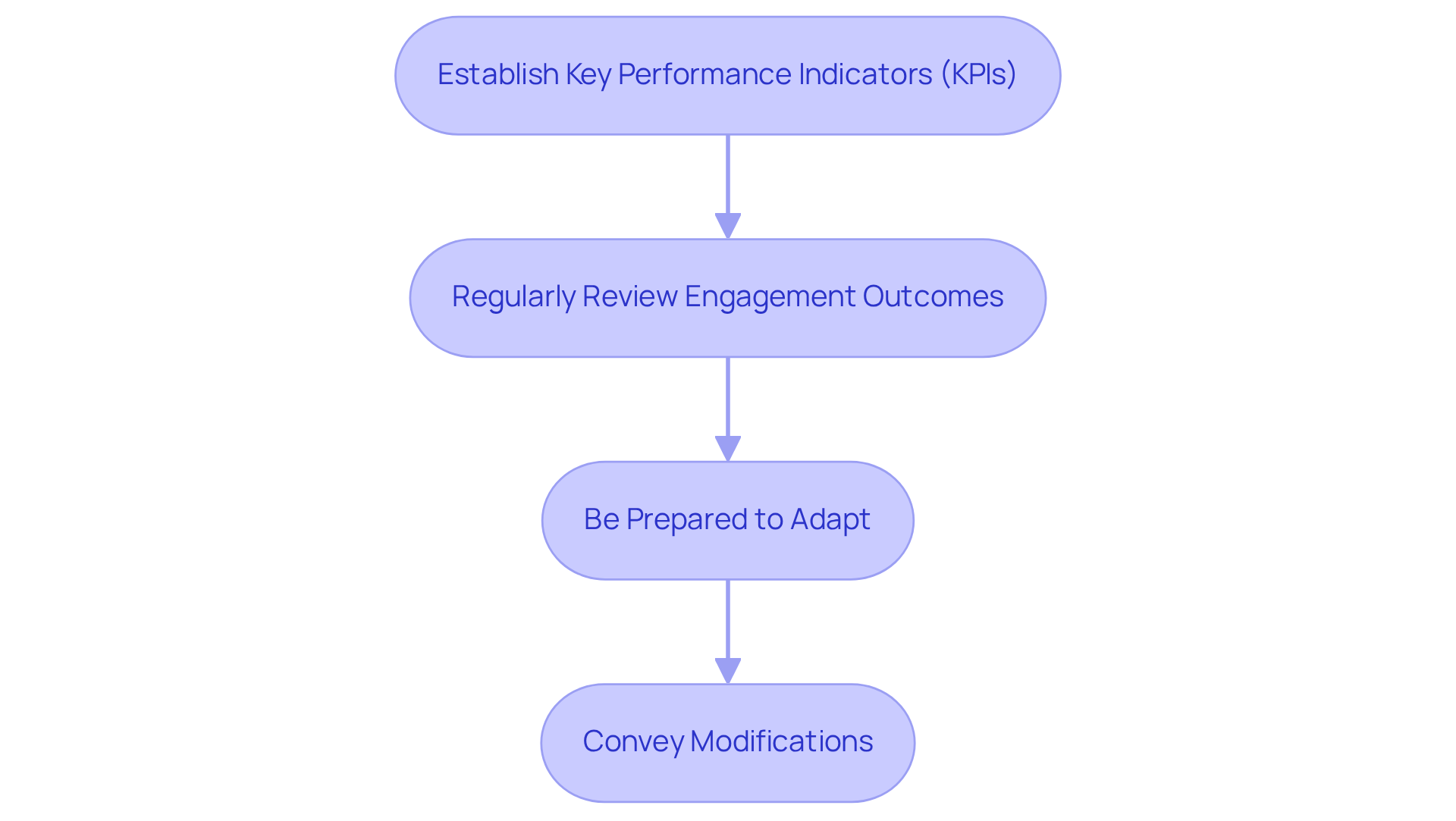Overview
This article delves into mastering the stakeholder management quadrant, a strategic tool essential for effective engagement. By categorizing stakeholders according to their influence and interest levels, it offers a structured methodology for identifying, categorizing, and engaging stakeholders. The emphasis on tailored communication strategies and continuous monitoring is crucial for enhancing project outcomes and ensuring stakeholder satisfaction.
Moreover, the insights provided here not only highlight the importance of stakeholder management but also articulate the desire for improved engagement. By implementing these strategies, professionals can significantly elevate their project's success rates.
Consequently, it is imperative to adopt these practices in your stakeholder management efforts. Embrace this structured approach to transform your engagement strategies and foster stronger relationships with your stakeholders.
Introduction
Understanding the dynamics of stakeholder engagement is crucial for the success of any project. The Stakeholder Management Quadrant serves as a powerful framework that categorizes stakeholders based on their influence and interest while guiding effective communication strategies tailored to each group.
However, with varying levels of power and engagement, how can project leaders ensure they are meeting the needs of their most influential stakeholders while fostering a sense of involvement among those with less power?
This article delves into mastering the Stakeholder Management Quadrant to enhance engagement strategies and drive project success.
Understand the Stakeholder Management Quadrant
The stakeholder management quadrant acts as a strategic tool that categorizes stakeholders into four distinct groups according to their level of influence and interest in an initiative. This classification includes:
- High Power, High Interest (Manage Closely): Often referred to as 'players,' stakeholders in this quadrant wield significant influence and exhibit strong interest in the initiative. Regular updates and active engagement are crucial to meeting their needs effectively.
- High Power, Low Interest (Keep Satisfied): Individuals in this category possess considerable influence but may not engage deeply in the initiative's day-to-day operations. Keeping them satisfied with minimal effort is essential to prevent them from becoming obstacles.
- Low Power, High Interest (Keep Informed): Stakeholders here, often termed 'subjects,' show interest in the project but lack the power to significantly influence it. Keeping them informed and engaged fosters goodwill and support.
- Low Power, Low Interest (Minimal Effort): These participants require the least attention. While they should not be ignored, extensive engagement is unnecessary.
Understanding the is vital for effectively prioritizing interactions with stakeholders and tailoring communication strategies. Additionally, it is important to recognize secondary participants, who, despite being overlooked, can significantly impact the project's outcomes. Furthermore, acknowledging decision-making authority and veto power within the project is essential for effective stakeholder management.
Incorporating insights from industry experts, such as Roman Pichler's emphasis on the importance of communication and Rachel Manktelow's categorization of interested parties, can enhance the understanding of strategies for engaging these stakeholders. Moreover, the impact of digitalization on engagement practices should not be underestimated, as it shapes modern approaches to managing relationships with involved parties.

Identify and Categorize Stakeholders
To efficiently handle interested parties, it is crucial to recognize all individuals or groups that may be impacted by or have a vested interest in your project, as outlined in the stakeholder management quadrant. Follow these steps:
- Brainstorm Potential Interested Parties: Assemble your team to list all possible involved individuals, including internal team members, external partners, customers, and regulatory bodies. This comprehensive approach ensures that all key players are considered within the stakeholder management quadrant.
- Utilize Interest Group Analysis Tools: Implement tools such as the or Mendelow's Matrix to categorize involved parties based on their influence and interest levels. This visualization helps prioritize engagement efforts efficiently, as companies that interact with involved parties are 50% more likely to reach their significant objectives. The stakeholder management quadrant helps in identifying individuals with high power and interest, guiding communication strategies.
- Conduct Interviews or Surveys: Actively engage with potential participants to gather insights into their interests, concerns, and expectations. This direct feedback is invaluable for precise categorization and fosters a sense of ownership among involved parties, leading to long-term commitment. As Latha Thamma Reddy observes, "By engaging with interested parties early and often, you can guarantee that they completely grasp what you are doing and recognize the advantages of your initiative."
- Document Findings: Create a stakeholder register that includes names, roles, influence levels, and interests. This document acts as an essential reference during the endeavor, ensuring that involvement approaches stay focused and efficient. Consistently assessing and refreshing this list is crucial as initiatives and business settings change.
By methodically recognizing and classifying interested parties in the stakeholder management quadrant, you can enhance your interaction approaches, ultimately resulting in better project outcomes and participant satisfaction. Furthermore, including interest group sentiment analysis and social listening can offer deeper insights into opinions and emotions, further enhancing your interaction strategy.

Develop Tailored Engagement Strategies
Once participants are recognized and classified, the subsequent step is to create customized interaction strategies. Here’s how to effectively engage with each group:
- Segment Interested Parties by the stakeholder management quadrant: Utilize the stakeholder management quadrant to determine the required level of engagement for each group. For instance, those in the stakeholder management quadrant known as 'Manage Closely' will require frequent updates and involvement, while participants in the 'Keep Informed' section of the stakeholder management quadrant may only need periodic newsletters.
- Craft Customized Communication Plans: Develop specific communication strategies tailored to each interest group. Consider their preferred communication channels—be it email, meetings, or reports—and determine the appropriate frequency of updates.
- Set Engagement Goals: Define clear objectives for each engagement strategy. For example, aim to obtain feedback from 'High Power, High Interest' parties to ensure their concerns are adequately addressed.
- Utilize Technology: Leverage project management tools and software to and monitor participant interactions. This approach can enhance clarity and sustain the involvement of interested parties.
By customizing interaction approaches to meet the unique requirements of each interested party, you can cultivate deeper connections and ensure that all opinions are acknowledged.

Monitor and Adjust Engagement Strategies
Observing and modifying participation approaches is essential for upholding satisfaction among interested parties within the stakeholder management quadrant and ensuring alignment with project goals. To enhance your approach, consider these key steps:
- Establish Key Performance Indicators (KPIs): Define specific KPIs to assess the effectiveness of your involvement strategies. Metrics such as participant feedback scores, attendance rates at meetings, and response rates to communications provide quantifiable insights into participant involvement success.
- Regularly Review Engagement Outcomes: Conduct periodic evaluations of your engagement approaches. To gauge stakeholders' perceptions and identify areas for improvement, utilize the to gather their feedback. This continuous assessment guarantees that your approaches remain pertinent and efficient.
- Be Prepared to Adapt: Stakeholder needs and project dynamics are not static; they evolve over time. Be ready to adjust your approaches based on input from interested parties and changing conditions. For instance, if an important participant expresses concerns, increasing their involvement in decision-making can enhance their satisfaction and commitment.
- Convey Modifications: When alterations are made to your involvement plans, promptly notify interested parties. Clarity in communication fosters trust and keeps interested parties engaged and aware of the initiative's direction.
By continuously monitoring and refining your engagement strategies in the stakeholder management quadrant, you strengthen stakeholder relationships, mitigate risks, and align efforts with project goals, ultimately contributing to sustainable business success.

Conclusion
Mastering the stakeholder management quadrant is essential for effective engagement in any project. This strategic framework not only categorizes stakeholders based on their influence and interest but also guides tailored communication and engagement strategies. By understanding the different groups within the quadrant, project managers can prioritize their interactions, ensuring that the needs of each stakeholder are met appropriately.
Key insights from the article emphasize the importance of:
- Accurately identifying and classifying stakeholders
- Developing customized engagement strategies
- Continuously monitoring and adjusting these strategies based on feedback
Tools and techniques such as the Power/Interest Grid and stakeholder sentiment analysis play a crucial role in enhancing engagement efforts, ultimately leading to better project outcomes and stakeholder satisfaction.
In conclusion, the significance of effective stakeholder management cannot be overstated. By utilizing the stakeholder management quadrant framework, project leaders are equipped to foster strong relationships, mitigate risks, and drive successful project execution. It is imperative to take action—begin implementing these strategies today to elevate stakeholder engagement and ensure project success in an increasingly complex business environment.
Frequently Asked Questions
What is the stakeholder management quadrant?
The stakeholder management quadrant is a strategic tool that categorizes stakeholders into four groups based on their level of influence and interest in an initiative.
What are the four categories of stakeholders in the quadrant?
The four categories are: 1. High Power, High Interest (Manage Closely) 2. High Power, Low Interest (Keep Satisfied) 3. Low Power, High Interest (Keep Informed) 4. Low Power, Low Interest (Minimal Effort)
How should stakeholders in the High Power, High Interest category be managed?
Stakeholders in this category, known as 'players,' should be managed closely through regular updates and active engagement to effectively meet their needs.
What is the approach for stakeholders in the High Power, Low Interest category?
Individuals in this category should be kept satisfied with minimal effort to prevent them from becoming obstacles, as they possess considerable influence but do not engage deeply in daily operations.
How should Low Power, High Interest stakeholders be treated?
These stakeholders, referred to as 'subjects,' should be kept informed and engaged to foster goodwill and support, even though they lack the power to significantly influence the project.
What is the management strategy for Low Power, Low Interest stakeholders?
Stakeholders in this category require minimal effort and attention. While they should not be ignored, extensive engagement is unnecessary.
Why is understanding the stakeholder management quadrant important?
It is vital for prioritizing interactions with stakeholders and tailoring communication strategies effectively.
What role do secondary participants play in stakeholder management?
Secondary participants, though often overlooked, can significantly impact the project's outcomes, making it important to recognize their influence.
What should be acknowledged for effective stakeholder management?
It is essential to recognize decision-making authority and veto power within the project for effective stakeholder management.
How can insights from industry experts enhance stakeholder engagement strategies?
Insights from experts, like Roman Pichler and Rachel Manktelow, can provide valuable perspectives on communication and categorization of interested parties, improving engagement strategies.
What impact does digitalization have on stakeholder engagement?
Digitalization shapes modern approaches to managing relationships with stakeholders, influencing engagement practices significantly.




